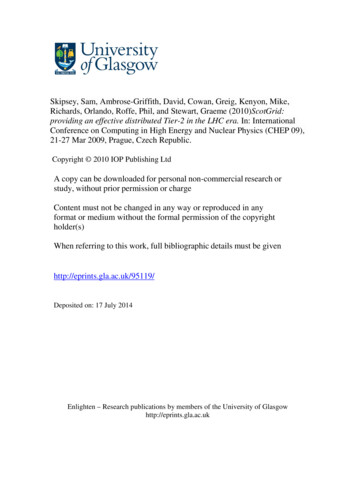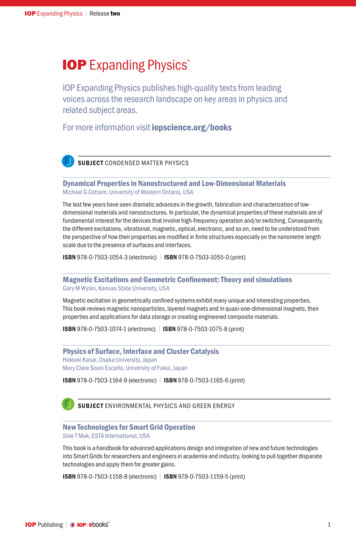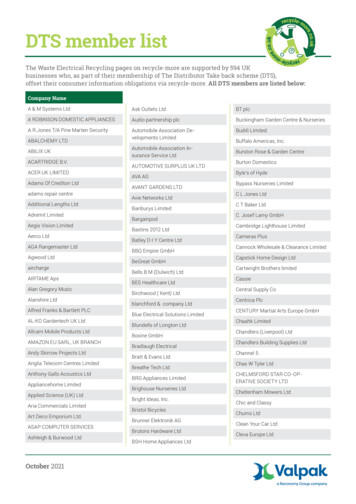
Transcription
Skipsey, Sam, Ambrose-Griffith, David, Cowan, Greig, Kenyon, Mike,Richards, Orlando, Roffe, Phil, and Stewart, Graeme (2010)ScotGrid:providing an effective distributed Tier-2 in the LHC era. In: InternationalConference on Computing in High Energy and Nuclear Physics (CHEP 09),21-27 Mar 2009, Prague, Czech Republic.Copyright 2010 IOP Publishing LtdA copy can be downloaded for personal non-commercial research orstudy, without prior permission or chargeContent must not be changed in any way or reproduced in anyformat or medium without the formal permission of the copyrightholder(s)When referring to this work, full bibliographic details must be givenhttp://eprints.gla.ac.uk/95119/Deposited on: 17 July 2014Enlighten – Research publications by members of the University of Glasgowhttp://eprints.gla.ac.uk
17th International Conference on Computing in High Energy and Nuclear Physics (CHEP09)IOP PublishingJournal of Physics: Conference Series 219 (2010) 052014doi:10.1088/1742-6596/219/5/052014ScotGrid: Providing an Effective Distributed Tier-2in the LHC EraSam Skipsey 1 , David Ambrose-Griffith 2 , Greig Cowan 3 , MikeKenyon 1 , Orlando Richards 3 , Phil Roffe 2 , Graeme Stewart 1123University of Glasgow, University Avenue, Glasgow G12 8QQDepartment of Physics, Durham University, South Road, Durham DH1 3LEDepartment of Physics, University of Edinburgh, Edinburgh, EH9 3JZE-mail: s.skipsey@physics.gla.ac.ukAbstract. ScotGrid is a distributed Tier-2 centre in the UK with sites in Durham, Edinburghand Glasgow, currently providing more than 4MSI2K and 500TB to the LHC VOs. Scalingup to this level of provision has brought many challenges to the Tier-2 and we show in thispaper how we have adopted new methods of organising the centres to meet these. We describehow we have coped with different operational models at the sites, especially concerning thosedeviations from the usual model in the UK. We show how ScotGrid has successfully providedan infrastructure for ATLAS and LHCb Monte Carlo production, and discuss the improvementsfor user analysis work that we have investigated. Finally, although these Tier-2 resources arepledged to the whole VO, we have established close links with our local user communities asbeing the best way to ensure that the Tier-2 functions effectively as a part of the LHC gridcomputing framework. In general conclusion, we find that effective communication is the mostimportant component of a well-functioning distributed Tier-2.1. IntroductionUnlike many other regions, the UK treats “Tier-2”1 centres as primarily administrativegroupings; UK-style “distributed” Tier-2s consist of multiple sites, grouped by region (e.g.ScotGrid[1] for mostly Scottish sites, NorthGrid for those in the north of England, &c), butnot abstracted at this level to present a single “Tier-2 site”2 to the grid. Each componentsite is visible as a distinct cluster and storage, with its own Compute Element, StorageElement, Site-BDII and other components. Each component site thus also has its own systemsadministration teams at the host location (mostly Universities), and has to abide by thehost’s requirements. Hierarchical control then passes through a “Tier-2 Coordinator” who isresponsible for shepherding the Tier-2 as a whole. The ScotGrid Tier-2 thus consists of siteshosted by the Universities of Glasgow, Edinburgh and Durham, administered in the mannerdescribed above. Due to the lack of an established term for component sites of a distributed1The WLCG model for compute and data provision is hierarchical, with Tier-0 as the root at CERN, Tier-1centres as the country-level resources for raw event storage, and data and compute distribution, and multipleTier-2 sites per country providing mainly compute capacity (they store data, but are not expected to providearchival services, unlike Tier-1s).2Compare, for example, to GRIF in France, which distributes its Tier-2 service geographically over the Île deFrance, but presents only a single site to the outside world.c 2010 IOP Publishing Ltd 1
17th International Conference on Computing in High Energy and Nuclear Physics (CHEP09)IOP PublishingJournal of Physics: Conference Series 219 (2010) 052014doi:10.1088/1742-6596/219/5/052014Tier-2, we will adopt the common terminology in the UK itself and refer to components as”Tier-2 sites” themselves, despite the ambiguity this introduces.This paper will attempt to provide an overview of challenges and solutions we haveencountered whilst establishing the Tier-2 and scaling it to provide the expected demand fromthe LHC.2. Fabric and People ManagementScotGrid has adopted several common best practices for the administration of componentsites. For configuration and fabric management, the Glasgow and Durham sites have adoptedcfengine[2] as an automation tool. Durham’s configuration is derived from the originalconfiguration scripts used by Glasgow, but omits low-level (non-cfengine) tools for imagingnodes and services.All sites use the Ganglia[3] fabric monitoring tool to collect historical and real-time datafrom all nodes in their sites. We have also configured a centralised nagios[4] alerting system,monitoring Glasgow’s systems directly, and Edinburgh and Durham via external tests (includingSAM test monitoring provided by Chris Brew of RAL).When failures or system problems are detected, a shared login server, hosted at Glasgow,allows sysadmins from any of the sites to log in with administrative rights to the other sites.This system is managed by ssh with public key security and host-based authentication, and istherefore fairly secure against external attacks.Recently, we have also established a “Virtual control room”3 , using the free, but proprietarySkype[5] VoIP and text messaging system. The control room, implemented as a “groupchatroom” has persistent historical state for all users who are members, allowing the full historyof conversations within the room to be retrieved by any user on login (including conversationsthat occurred during periods they were not present). We believe that this feature is not availableas standard functionality in any other application. The virtual control room has already provedof great value, enabling advice and technical assistance to be provided during periods of criticalservice downtime. As the Tier-2 is distributed, so is the expertise; a common control roomallows this expertise to easily be shared in a way that community blogs and mailing lists can’treplicate.2.1. Local servicesThe gLite middleware has a natural hierarchical structure, such that information flows upfrom all services into a small number of “top-level” services (“Top-level BDIIs”4 ) with globalinformation, and similarly control and job distribution flows out from a small number of“Workload Management Services”5 to all the compute resources. As such, it was originallyenvisaged that the Top-level BDII and WMS services would exist at the Tier-1 level. However,for historical reasons, and due to the unreliability of WMS services, ScotGrid manages its owncopies of both services, which are used by all the sites in the Tier-2. Top-level BDIIs are easyto administer, and do not require any complicated configuration; they are essentially ldap[6]servers with some tweaks applied.The glite WMS (technically two services: the WMS itself and the “Logging and Bookkeeping”service that maintains records) has developed a reputation for being hard to administer and3That is, a grandiose name for a virtual space intended for the coordination of technical effort in real time.Berkeley Database Information Index; essentially a service providing a queryable tree of information aboutall services which it itself can query. The top-level BDII, by definition, queries all site BDIIs, which themselvesquery their component services’ information providers. The top-level BDIIs are used by, for example, WorkloadManagement Systems to decide where to place jobs.5A brokering service for distributing jobs centrally to the most appropriate resource for them, as determined byglobal information and the job requirements.42
17th International Conference on Computing in High Energy and Nuclear Physics (CHEP09)IOP PublishingJournal of Physics: Conference Series 219 (2010) 052014doi:10.1088/1742-6596/219/5/052014maintain. The ScotGrid WMS at Glasgow was set up in order to reduce our dependance on the(then single) WMS instance at the Tier-1, removing the single point of failure this represented forjob submission. Since then, the RAL Tier-1’s WMS service has become somewhat more reliable,with the aid of extensive load-balancing; however, the WMS as a service is still the least stablepart of the job control process, and is still a major cause of test failures against sites. OtherTier-2s have begun installing their own local WMSes in order to reclaim control of these testfailures, as it is psychologically stressful to experience failures outside of your influence. Thisshould, of course, be balanced against the particularly large time component which must bedevoted to keeping the WMS services working correctly; a single user can significantly degradethe performance of a WMS service by submitting large (on the order of thousands) of jobs toone, and then not cleaning their job output up (which the WMS retrieves on job completion,and holds ready for the user to collect).In addition, Durham run their own WMS instance for use by local users and for trainingpurposes. This is not enabled as a service for users outside of Durham currently; it is mentionedhere to avoid confusion in the later discussion of Durham system implementation.Glasgow also runs its own VOMS server, although not to duplicate central services at the Tier1 or RAL. ScotGrid supports several local VOs, one of which will be discussed later in this paper,and the VOMS server is necessary to support user membership, authentication and authorisationcontrol for those entities. Possessing a VOMS server gives us additional flexibility in supportinglocal users, especially those who are interested in merely “trying out” the grid, without wantingto invest in the overhead of creating their own VO. Indeed, as one of our roles is to encourage useof Grid infrastructure, it is exceptionally useful to be able to ease potential user groups into useof our infrastructure without the red-tape that would otherwise be required to gain access forthem; we can immediately give them membership in the local vo.scotgrid.ac.uk VO, allowingthem to (relatively) painlessly test out the local infrastructure using grid techniques.3. “Special cases”Whilst Glasgow’s configuration is generally “standard”6 in terms of common practice at otherUK Tier-2s, Durham and Edinburgh both have nonstandard aspects to their site configuration.Durham host their front-end services on virtual machines; Edinburgh’s compute provision is viaa share of a central university service, rather than a dedicated service for WLCG.3.1. Durham: Virtual MachinesIn December 2008, Durham upgraded their entire site with the aid of funding from . As part ofthis process, the front-end grid services were implemented as VMware[7] virtual machines on asmall number of very powerful physical hosts.Two identical hosts, “grid-vhost1.dur.scotgrid.ac.uk” and “grid-vhost2.dur.scotgrid.ac.uk”,configured with dual quad-core Intel Xeon E5420 processors, 16 Gb RAM and dual (channelbonded) Gigabit ethernet. The services can therefore be virtualised easily in “blocks” of (1 core 2 Gb RAM), allowing different services to be provisioned with proportionate shares of thetotal host. Using VMware Server 2.0 limits the size of a given virtual machine to two cores,which does present a practical limit on the power assignable to any given service. In many cases,this can be ameliorated by simply instantiating more than one VM supporting that service, andbalancing load across them (this works for compute elements each exposing the same cluster,but storage elements cannot share storage and so cannot load balance in the same way).The current configuration allocates one block each of grid-vhost1 to VMs for gangliamonitoring, cfengine and other install services, and the glite-mon service, two blocks to the6In the sense that Glasgow currently hosts all its services on physical servers, and has total administrative controlof the entire infrastructure of the cluster services, forcing access via Grid mechanisms. Note that since this paperwas originally written, the “standard” has begun to shift, particularly as regards to virtual machine use.3
17th International Conference on Computing in High Energy and Nuclear Physics (CHEP09)IOP PublishingJournal of Physics: Conference Series 219 (2010) 052014doi:10.1088/1742-6596/219/5/052014VM hosting the first Compute Element. Two blocks plus the remaining 4Gb of RAM to thelocal Durham WMS service, as WMS services are extremely memory hungry. This leaves onecore unallocatable to additional VMs as there is no unallocated memory to assign.Grid-vhost2 devotes one block each to the Site-level BDII service and the local resourcemanagement system (Torque[8]/Maui[9]), two blocks to a second CE service to spread load,and two cores and 2Gb ram to a storage element service using DPM. As will be shown later inthe paper, this configuration does not provide sufficient compute power to the storage element,but load-balancing is non-trivial for DPM and other commonly implementations of the SRMprotocol, so performance increases will have to be attempted via configuration tuning initially.In all cases, the virtual machine files themselves are hosted on NFS filesystems exported froma master node, via dual (channel-bonded) Gigabit ethernet. The local filesystem is mounted on2TB of fibre-channel RAID for performance and security. Interestingly, exporting this filesystemover NFS gave better performance than the local disks in the virtual machine hosts. As thevirtual machine files are hosted on a central service, it is trivial to move services between thetwo virtual machine hosts, in cases where one host needs maintenance.Outside of ScotGrid, the Oxford site (part of SouthGrid) has also installed front-end servicesas virtual machines. Considering the growing acceptance of virtualisation as a means ofsupporting multiple applications efficiently on the increasingly multicore architectures of modernCPUs, we see this becoming a mainstream configuration across the WLCG in the next five years.3.2. Edinburgh: Central ServicesHistorically, Edinburgh’s contribution to ScotGrid has been storage-heavy and compute-light.This was a legacy of the initial experiment of the ScotGrid configuration, where Glasgow wasintended to host compute services and Edinburgh storage, with fast networking allowing theseto act as mutually local resources. This turned out to not be feasible at the time, althoughNorduGrid[10] has effectively proved that such a scheme can succeed, albeit with their ownmiddleware stack rather than gLite.As a result, the paucity of Edinburghs installed cluster resources lead to a decision, in 2006,to decommission the old site, replacing it with a new site with compute power provided bythe then-planned central university compute resource, ECDF (the Edinburgh Compute andData Facility). As the ECDF is a shared university resource, its main loyalty must be to thelocal University users, rather than to the WLCG. This is a currently unusual, but increasinglycommon state of affairs, and requires some adjustment of expectations on both sides.In particular, as local users cant be forced to use the grid middleware to submit their jobs(preferring direct access), the normal installation process for worker nodes cant be performed asthey pollute the local environment with non-standard libraries, services and cron jobs. Instead,the “tarball” distribution of the glite-WN is deployed, via the clusters shared filesystem (thisdistribution is simply a packed directory structure containing the WN services, which can beunpacked into whatever root directory is feasible). However, even the tarball distributionrequires cron jobs to be installed to maintain the freshness of CRL files for all supportedCertificate Authorities; these are instead run from the Compute Element, which has accessto the instance of the CA certificate directory on the shared filesystem.Services like the Compute and Storage Elements all run on services which are physicallyadministered by the ECDF sysadmins, but software administered by a separate “middlewareteam who were partly funded by GridPP to provide this service. As a result, the installationand configuration of these “front-end nodes” is broadly similar to that in other Tier-2 sites; thesole exception being the interface to the local resource management system, in this case Sun GridEngine[11]. Again, the default configuration procedure for gLite middleware via YAIM involvesconfiguration of the LRMS as well as the CEs that attach to it; this is highly undesirable in thecase of a shared resource, as the queue configuration has usually already been arranged correctly.4
17th International Conference on Computing in High Energy and Nuclear Physics (CHEP09)IOP PublishingJournal of Physics: Conference Series 219 (2010) 052014doi:10.1088/1742-6596/219/5/052014As a result, configuration of the CEs was performed partly by hand, and required some recodingof the jobmanager scripts provided by the gLite RPMs.Whilst the resulting system is functional, the necessity of not using YAIM to configure someelements of the compute provision (both CE and worker nodes) reduces the agility of the site inresponse to middleware updates. Despite this, Edinburgh/ECDF has managed to be a successfulTier-2 site, after all the pitfalls were worked through.4. WLCG/EGEE UseThe configuration and management procedures mentioned in the previous section have enabledScotGrid to provide significant, and reliable, resources to the WLCG VOs. The workloadpresented by these VOs can be divided into two main classifications: Monte-Carlo production,the generation of simulated datasets for use in later analysis of detector data; and user analysis,which comprises all activities involving “real data from the LHC itself. Production work bythe LHCb and ATLAS VOs has been on-going on ScotGrid sites for several years, and is wellunderstood; User Analysis, conversely, has been necessarily limited by the delayed operation ofthe LHC itself. The LHCb compute model reserves Tier-1 sites for user analysis processes, andso we would only expect significant analysis activity from the ATLAS VO when the LHC beginsoperation.4.1. ProductionAs Production work is well established, all VOs have detailed historical logs which can beaccessed to investigate the relative effectiveness of sites. We will briefly discuss some statisticsfrom the LHCb and ATLAS VOs regarding recent Production work as concerns ScotGrid sites.4.1.1. LHCb Figure 1 shows the number of successful LHCb production jobs accumulated byScotGrid sites over a 6 month period ending in the 11th week of 2009. The point at whichDurham’s site became active is clearly visible as the rapidly increasing green area to the righthand side of the plot.Between September 2008 and February 2009 inclusive, ScotGrid had processed almost 90,000LHCb jobs; 20,000 of those arrived at Durham in February alone, although the “bursty” natureof LHCb production demand prevents us from concluding that Durham is as dramatically betterthan the other sites as this would initially seem. Indeed, almost half of the entire cumulativedistribution occurs in the month of February, a reflection more on the VO’s increased demandthan on Tier-2 itself.4.1.2. ATLAS Table 1 shows the statistics for ATLAS Production jobs passing throughScotGrid sites during the middle of March 2009. As can be seen, Glasgow processed almost18% of the total ATLAS production workload in the sampled period. Considering that this dataincludes the Tier-1, which handled almost 50% of the total, this is a particularly impressivestatistic for ScotGrid. By comparison, Edinburgh is comparable to the average Tier-2 site,and Durham happens to look particularly unimpressive in this accounting because of on-goingproblems with ATLAS jobs not targeting their site. Even with these problems, Durham, incommon with the other component sites, surpasses the average efficiencies for sites in the UKsignificantly.A more recent sample of the state of ATLAS production, presented in table 2 shows that afterDurhams initial teething problems were fixed, it is fully capable of matching the performanceof other UKI sites. Indeed, in this sampling, all of the ScotGrid sites surpass the average job(walltime) efficiency for the UK.5
17th International Conference on Computing in High Energy and Nuclear Physics (CHEP09)IOP PublishingJournal of Physics: Conference Series 219 (2010) 052014doi:10.1088/1742-6596/219/5/052014Figure 1. Cumulative LHCb Production work on ScotGrid sites over a 6 month period endingin March 2009. Glasgow is represented by both blue and yellow areas due to a change in theinternal names used to represent sites in the LHCb accounting software. Durham is representedby the green area and ECDF/Edinburgh by the red.Table 1. ATLAS Production (March 09). Walltime figures are given in minutes,“Success” and“Failure” values are total numbers of jobs.SiteSuccessFailureWalltime (success)GlasgowEdinburghDurhamTotal 35756242504188 9 109EfficiencyWalltime Table 2. ATLAS Production (April 09). Taken from the first 21 days of April, reported inATLAS Prodsys tool. Walltime figures are given in minutes,“Success” and “Failure” values aretotal numbers of jobs.SiteSuccessFailureWalltime (success)GlasgowEdinburghDurhamTotal 8654405200 4 1096EfficiencyWalltime Efficiency96.6%87.4%93.0%89.2%99.6%97.7%94.9%92.9%
17th International Conference on Computing in High Energy and Nuclear Physics (CHEP09)IOP PublishingJournal of Physics: Conference Series 219 (2010) 052014doi:10.1088/1742-6596/219/5/0520144.2. ATLAS User AnalysisAlthough it has been suspected for some time that user analysis activities would present adifferent load pattern to production, until recently there has been surprisingly little workdone in trying to quantify these differences. Indeed, if the LHC had begun operation ontime, we would have been taking user analysis jobs without any solid knowledge of how theywould perform. The delayed operation of the LHC has allowed the ATLAS VO to begin acampaign of automated tests against all Tiers of the WLCG infrastructure in order to begin suchquantification work. Leveraging the Ganga[13] Python-scriptable grid user interface framework,the HammerCloud[14] tests submit large numbers of a “typical” ATLAS user analysis job toselected sites, allowing load representative of that from a functioning LHC to be presented ondemand.In general, it is found that the ATLAS analysis workload stresses storage elements much moresignificantly than production work can. Although the ATLAS VO is in the process of adaptingits workflow to reduce such load, it is clear that provisioning of site infrastructure on the basis ofproduction workflow has resulted in many sites, including those in ScotGrid, being significantlyunderpowered for optimal analysis performance.An analysis of the performance of Glasgow under HammerCloud tests, including optimisationwork undertaken is presented in our other paper in this proceedings[15]. The fundamentalcomplicating issue for user analysis is the sheer amount of (internal) data movement they require;a given analysis job may pull gigabytes of data to its worker node’s disk, and will access thatdata with random seeks, causing greater stress on the storage infrastructure than the streamed,and relatively small volume, access mode of most production work. Additionally to this is thesheer unpredictability of user analysis; users can, in principle, submit any job to the grid, andthere is no guarantee that all users’ work will be equally performant (or have identical datamovement patterns).Durham has also begun testing the performance of their infrastructure, revealing similarproblems to those at Glasgow before tuning was begun. Whilst 2 cores of an Intel Xeon processorare more than sufficient to support load on DPM services from production use, the extremefrequency of get requests generated by analysis jobs results in the node becoming saturated andeffective performance bottlenecked.5. Local UsersAs well as provision for WLCG/EGEE users, ScotGrid sites also have user communities local toeach site. In this section, we will provide a brief overview of how these local users are provisionedand supported at Glasgow.5.1. Glasgow “Tier-2.5”One of the largest groups of local users at Glasgow are the local particle physicists themselves.Whilst these users are all members of WLCG VOs and could simply submit jobs via the highlevel submission frameworks, it is useful for them to be able to access other local resources whenchoosing to run jobs at the Glasgow site. This mode of operation, merging personal resources(often informally regarded as “Tier 3” of the WLCG) and Tier-2 compute provision is referredto as “Tier-2.5” provision within Glasgow.The implementation mostly concerns tweaks to user mapping and access control lists, so thatlocal users can be mapped from their certificate DN to their University of Glasgow username,rather than a generic pool account, whilst mapping their unix group to the same group asa generic VO member. This process involves some delicate manipulation of the LCMAPScredential mapping system: LCMAPS will only allow a given method of user mapping to bespecified once in its configuration file; however, the Tier-2.5 mappings uses the same method7
17th International Conference on Computing in High Energy and Nuclear Physics (CHEP09)IOP PublishingJournal of Physics: Conference Series 219 (2010) 052014doi:10.1088/1742-6596/219/5/052014(mappings from predefined list) as the default mapping method. The solution is to make a copyof the mapping plugin required, and call the copy for the Tier-2.5 mappings.The resultant combination of user and group memberships allows Tier-2.5 users to accesslocal University resources transparently, whilst also allowing them to access their WLCG-levelresources and software. The provision of a local gLite User Interface service with transparent(ssh key) based login for local Physics users also helps to streamline access.Similarly, the Glasgow site’s storage elements allow local access to ATLAS datasets stored onthem via the rfio and xroot protocols, through the use of their grid credentials whilst mappedto their local accounts. As the capacity of the Glasgow storage system is significant, this allowslarge data collections to be easily cached locally by researchers without the need for externalstorage.5.2. Glasgow NanoCMOSThe other significant user community at Glasgow are represented by the “NanoCMOS” VO,which represents electrical engineers engaged in simulation of CMOS devices at multiple levelsof detail (from atomistic simulations to simulations of whole processors). As the only supportedmeans of submitting to the Glasgow cluster is via the gLite interfaces, local NanoCMOS memberscurrently use Ganga to submit jobs to the Glasgow WMS instances.The typical NanoCMOS workload involves parameter sweeps across a single simulation, inorder to generate characterisation of I/V curves and other data. This means that a single userwill submit hundreds of subjobs to the WMS, which has challenged the scalability of the existinginfrastructure. (Compare this to the recommendation that batches of jobs submitted to a gLiteWMS should be of order 50 to 100 subjobs). Even the lcg-CE service has scalability problemsin receiving on the order of 1000 jobs in a small time period; whilst it can manage thousandsof concurrent runningjobs, the load on the CE is significantly higher during job submissionand job completion, leading to component processes sometimes zombifying under the stress ofmassively bulky submission. Educating NanoCMOS users to stagger job submissions mitigatestheir effect on the system load, but this is an on-going problem. We are currently exploringother CE solutions, both the CREAM-CE and the NorduGrid ARC-CE, in order to examinetheir performance under similar load.6. ConclusionsThis paper has presented an overview of the configuration and management decisions made atthe ScotGrid distributed Tier-2. We have discussed the ways in which two of our componentsites deviate from the “standard” configuration of a WLCG site; both of which are likely tobecome mainstream given time.In general, we have found that means of enhancing communication between the componentsites are the most effective things to implement. The “virtual control room”, in particular,has been of signal benefit to all of the sites in organising effort and transferring expertise inreal-time. There is also an apparently unavoidable tension between the demands of WLCGuse and those of local users, both for a traditional site with wholly-gLite mediated interfaceslike Glasgow, and for a highly non-traditional site with a bias towards low-level access likeEdinburgh/ECDF. LHCb and ATLAS statistics demonstrate that we are very successful Tier-2from the perspective of Monte-Carlo production, which makes the difficulties we have had withsimulated User Analysis load particularly notable (although much of this discussion is outsideof the scope of this paper). It is likely that this will be our most significant issue in the comingyear, although work is continuing to address this challenge.Future expansion and development is, of course, contingent on circumstances outside ourcontrol; however, we have begun investigating possible directions for future growth, primarilyat Glasgow. Some of
from all nodes in their sites. We have also configured a centralised nagios[4] alerting system, monitoring Glasgow's systems directly, and Edinburgh and Durham via external tests (including SAM test monitoring provided by Chris Brew of RAL). When failures or system problems are detected, a shared login server, hosted at Glasgow,










